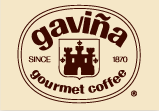The History of Coffee
If you’ve read about the history of our family and our coffee company, you know where Gaviña coffee comes from. But even our 140 years in this business is just a drop in the cup when you compare it to the history of this favorite beverage. Let’s take a look at coffee through the centuries. There are many versions of the history of coffee, but this is our favorite.
Our Favorite Story
One day, an Ethiopian goat herder named Kaldi saw his goats prancing in a field and wondered why they were acting so lively. Noticing they were eating the berries of a tree, he tried one himself. He found the fruit of this tree to be fairly bland, but vaguely sweet and mildly refreshing. After a few minutes, he was feeling quite lively himself—frolicking and prancing about like a young kid.
When the goat herder realized the effect these berries were having, he gathered a handful to take to the local abbot. This religious man tried the fruit and pronounced it a gift from God, created so that he and his faithful monks could stay up all night to pray.
At some point, the habit of drying the berries for storage and transport became popular. They were eaten like raisins or mixed with dried grains to make granola. There were no coffee shops yet (since coffee wouldn’t be invented until much later). So munching on caffeinated snacks was a great way to stay invigorated on the road.
Early Coffee Drinks
Before coffee was coffee, it was tea! In Yemen, it was a common practice to use coffee cherries, beans, and leaves to make a type of sun tea called “qishr.” It was used as a medicinal preparation for its energizing effects. This sun tea or brew is still popular today in the Middle East and Africa.
If this tea was sweetened and allowed to ferment, it would turn into a mildly alcoholic beverage, a little like wine. This was the first drink to receive the Arabic name “qahwah, which means, “to put one off”—as in “to put one off sleep.” Today, that word has become “coffee.”
Brewed Coffee, Finally
It was not until the early 1400s that brewed coffee was created. This was about the same time that metal pots, in which water could be boiled over a fire, appeared in that part of the East. This invention made it possible for the coffee sun tea to be made more quickly by boiling leaves, cherries, and seeds in water. The combination of fire and coffee seeds most probably led to the creation of coffee. Perhaps a pot of tea boiled dry or tipped into the fire, giving the world the first brewed coffee from roasted beans.
Coffee Reaches Europe
One of the first actual appearances of coffee in Europe occurred during the reign of Pope Clement VIII. The brew was then known to be the drink of choice of Muslims (since it contained no alcohol). This association with another religion immediately alarmed the Vatican who wanted to outlaw the brew. The Pope, however, had the desire to learn more about the beverage and fell immediately in love with its aroma. Tempted, he tried a cupful. Instead of banning it, he “baptized” it as “a truly Christian beverage.”
Venice, Italy lays claim to establishing the first coffee house on the Piazza di San Marco in 1792. The French and Austrians come in a close second by greatly improving the look, style, and ambiance of their shops. From these humble beginnings, coffee spread rapidly throughout Europe and the developed world.
New York to Boston
It wasn’t until about 1683 that Americans discovered coffee. New York, known as New Amsterdam at the time, mimicked the afternoon tea habits of their English brothers. One of the first recorded coffee drinkers was William Penn. After he settled in his Pennsylvania Colony, Penn hired a New York importer to secure a stash of coffee for his personal use.
Strangely enough, this trend toward coffee in America can be largely attributed to tea. In 1773, our Bostonian ancestors hosted the Boston Tea Party, proclaiming freedom from Britain and selected coffee as the American patriotic beverage of choice.
Celebrate Each Day with a Toast to the Perfect Roast
Coffee has come a long way over the years, and we’re glad to be part of the history of this amazing beverage.




